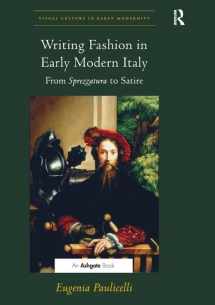
Writing Fashion in Early Modern Italy: From Sprezzatura to Satire (Visual Culture in Early Modernity)
ISBN-13:
9781138269583
ISBN-10:
1138269581
Edition:
1
Author:
Eugenia Paulicelli
Publication date:
2016
Publisher:
Routledge
Format:
Paperback
286 pages
Category:
History
,
Fashion
,
History
,
Arts History & Criticism
FREE US shipping
Book details
ISBN-13:
9781138269583
ISBN-10:
1138269581
Edition:
1
Author:
Eugenia Paulicelli
Publication date:
2016
Publisher:
Routledge
Format:
Paperback
286 pages
Category:
History
,
Fashion
,
History
,
Arts History & Criticism
Summary
Writing Fashion in Early Modern Italy: From Sprezzatura to Satire (Visual Culture in Early Modernity) (ISBN-13: 9781138269583 and ISBN-10: 1138269581), written by authors
Eugenia Paulicelli, was published by Routledge in 2016.
With an overall rating of 4.1 stars, it's a notable title among other
History
(Fashion, History, Arts History & Criticism) books. You can easily purchase or rent Writing Fashion in Early Modern Italy: From Sprezzatura to Satire (Visual Culture in Early Modernity) (Paperback) from BooksRun,
along with many other new and used
History
books
and textbooks.
And, if you're looking to sell your copy, our current buyback offer is $0.3.
Description
The first comprehensive study on the role of Italian fashion and Italian literature, this book analyzes clothing and fashion as described and represented in literary texts and costume books in the Italy of the 16th and 17th centuries. Writing Fashion in Early Modern Italy emphasizes the centrality of Italian literature and culture for understanding modern theories of fashion and gauging its impact in the shaping of codes of civility and taste in Europe and the West. Using literature to uncover what has been called the ’animatedness of clothing,’ author Eugenia Paulicelli explores the political meanings that clothing produces in public space. At the core of the book is the idea that the texts examined here act as maps that, first, pinpoint the establishment of fashion as a social institution of modernity; and, second, gauge the meaning of clothing at a personal and a political level. As well as Castiglione’s The Book of the Courtier and Cesare Vecellio’s The Clothing of the Renaissance World, the author looks at works by Italian writers whose books are not yet available in English translation, such as those by Giacomo Franco, Arcangela Tarabotti, and Agostino Lampugnani. Paying particular attention to literature and the relevance of clothing in the shaping of codes of civility and style, this volume complements the existing and important works on Italian fashion and material culture in the Renaissance. It makes the case for the centrality of Italian literature and the interconnectedness of texts from a variety of genres for an understanding of the history of Italian style, and serves to contextualize the debate on dress in other European literatures.


We would LOVE it if you could help us and other readers by reviewing the book
Book review

Congratulations! We have received your book review.
{user}
{createdAt}
by {truncated_author}


